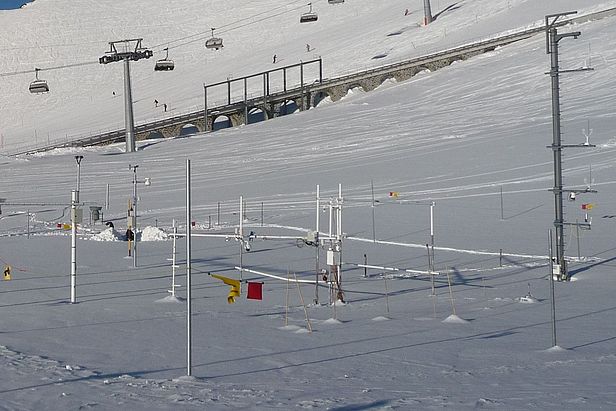18.12.2017 | News
Since 2017, the SLF's test sites have been part of a global network of monitoring stations collecting and analysing data on the cryosphere.
Our planet's snow and ice-covered regions – the so-called cryosphere – are particularly prone to change as a result of global warming: glaciers are melting, permanently frozen soil is thawing and many places are getting less and less snow. Feedback effects mean that changes like this can accelerate global warming. "This is why it's important to gain as much knowledge as possible about the state of the cryosphere", says Charles Fierz, Head of the SLF's Snow Cover and Micrometeorology Group.
This is the same goal pursued by the World Meteorological Organisation (WMO), which is currently setting up a monitoring programme. At its heart is the CryoNet observing system, which combines meteorological and snow data from existing measuring stations around the world. Since 2017, this network has also included various SLF test sites in the Davos region (see box), which feed measurement data on the condition of snow and ice, but also on the weather, into the CryoNet system. Depending on the measurement location and method, these data include snow depths, snow cover, snow profiles, air temperature, soil temperature and solar radiation.
Continuous datasets ¶
To be able to contribute to the CryoNet network, stations must be able to demonstrate compliance with certain quality standards and guarantee continuous measurements, not just in the past, but especially in the future. The series of measurements taken by the SLF meet this requirement. Some of them even go back 80 years or more. "Such continuous data sets are particularly valuable", stresses Martin Schneebeli, Head of the Snow Physics research unit. For him, the important thing about the CryoNet is that it brings together previously isolated information. "You should think of the network as a library", he says. Amassed knowledge is freely accessible. In future researchers around the world can use it to gain a fuller picture of the state of the cryosphere.
The SLF's test sites ¶
The SLF's best-known test site is located on the Weissfluhjoch above Davos (2,540 m above sea level). The facility was set up in 1936 and provides measurement series on snow depth, snow water equivalent, the depth of fresh snow and its water value as well as snow profiles. Since the 1950s, the SLF has also been running the Stillberg test site in the Dischma Valley, one of the topics being studied today is the impact of climate change on the tree line. The Laret test site near Davos, opened in 2016, is for now primarily taking measurements connected to the remote sensing of snow and ice.
Contact ¶
Copyright ¶
WSL and SLF provide image and sound material free of charge for use in the context of press contributions in connection with this media release. The transfer of this material to image, sound and/or video databases and the sale of the material by third parties are not permitted.

